1995 BUICK REGAL service
[x] Cancel search: servicePage 3 of 340
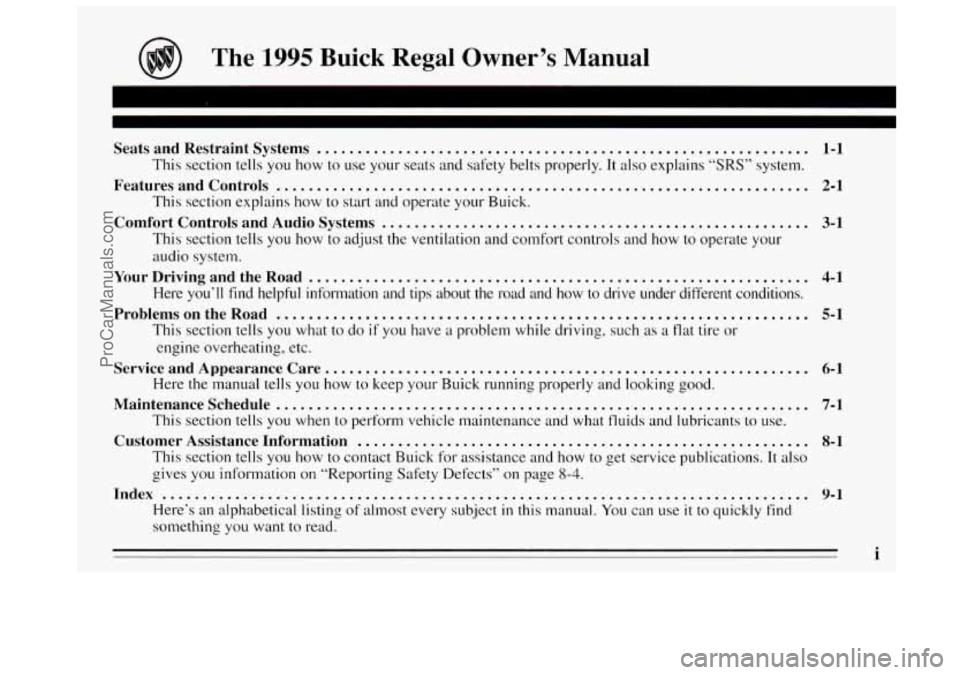
The 1995 Buick Regal Owner's Manual
I
Seats and Restraint Systems .............................................................
This section tells you how to use your seats and safety belts properly. It also explains "SRS" system.
Featuresandcontrols ..................................................................
This section explains how to start and operate your Buick.
Comfort Controls and Audio Systems .....................................................
This section tells you how to adjust the ventilation and comfort controls and how to operate your
audio system.
YourDrivingandtheRoad ..............................................................
Here y6u'll find helpful info]-mation and tips about the road and how to drive under dif-ferent conditions.
ProblemsontheRoad ..................................................................
This section tells you what to do if you have a problem while driving. such as a flat tire or
engine overheating. etc.
ServiceandAppearanceCare ............................................................
Here the manual tells you how to kccp your Buick running properly and looking good.
Maintenanceschedule ..................................................................
This section tells you when to perform vehicle maintenance and what fluids and lubricants to use.
Customer Assistance Information ........................................................
This section tells you how to contact Buick for assistance and how to get service publications. It also
gives you infortnation on "Reporting Safety Defects.' on page 8-4.
Index ........................................................................\
........
Here's an alphabetical listing of almost every sub.ject in this n1anual. You can use it to quickly find
something you want
to read.
1-1
2- 1
3-1
4- 1
5- 1
6- 1
7- 1
8- 1
9- 1
1
ProCarManuals.com
Page 4 of 340
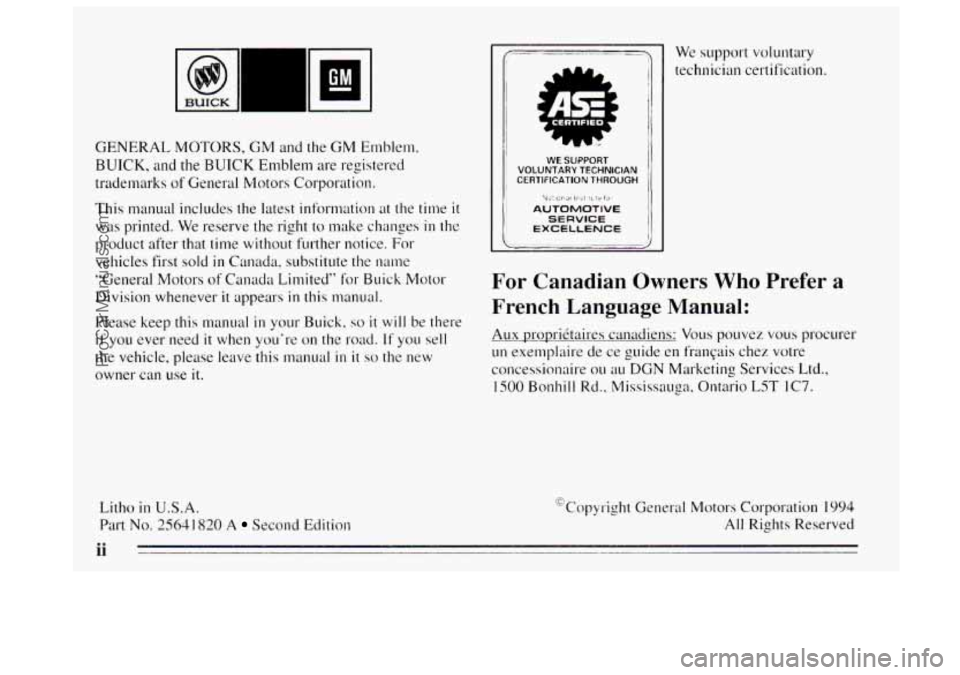
GmRAL MOTORS, GM and the GM Emblem,
BUICK, and
the BUICK Emblem are registered
tradernarks of General h4otot.s Corporation.
This manual includes the latest information at the time
it
was printed. We reserve the right to make changes in the
product after that time without further notice.
For
vehicles first sold in Canada, substitute the name
“General Motors of Canada Limited” for Buick
Motor
Division whene.ver it appears in this manual.
Please keep this manual
in your Buick, so it will be there
if you ever need it when you’re on the road. If you sell
the vehicle, please leave this manual
in it so the new
owner can use it.
Litho in U.S.A.
Part No. 2564 I820 A Second Edition
II II I WE SUPPORT VOLUNTARY TECHNICIAN CERTIFICATION THROUGH I
I AUTOMOTIVE
us:Icn31 In;l It t.-’fO~
SERVICE EXCELLENCE
I We support vo
~ technician cerl ‘luntary
:ification.
For Canadian Owners Who Prefer a
French Language Manual:
Aux Drouriktaires
canadiens: VOLIS pouvez vous procurer
un exemplaire de ce guide en franqais chez votre
concessionaire ou au
DGN Marketing Services Ltd.,
IS00 Bonhill Rd., Mississauga, Ontario LST 1C7.
@Copyright General Motors Corporation
1994
All Rights Reserved
ii
ProCarManuals.com
Page 9 of 340
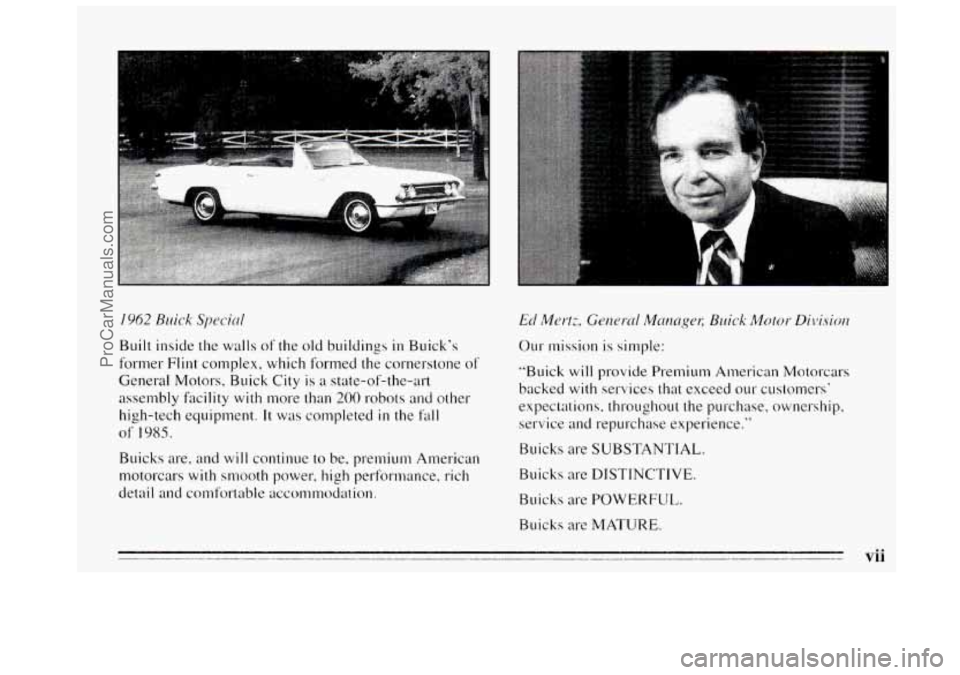
I962 Buick Special
Built inside the walls of the old buildings in Buick’s
former
Flint complex, which formed the cornerstone of
General Motors. Buick City is a state-of-the-art
assembly facility with more than
200 robots and other
high-tech equipment.
It was completed in the fall
of 1985.
Buicks are, and will continue to be, premium American
lnotorcars with smooth power, high performance, rich
detail and comfortable accommodation.
Ed /Vert,-., Genercrl Manager; Buick Motor Dilisiorz
Our mission is simple:
“Buick
will provide Premium American Motorcars
backed
with services that exceed our customers’
expectations, throughout the purchase, ownership,
service and repurchase experience.”
Buicks are SUBSTANTIAL.
Buicks are DISTINCTIVE.
Buicks are
POWERFUL.
Buicks are MATURE.
ProCarManuals.com
Page 34 of 340
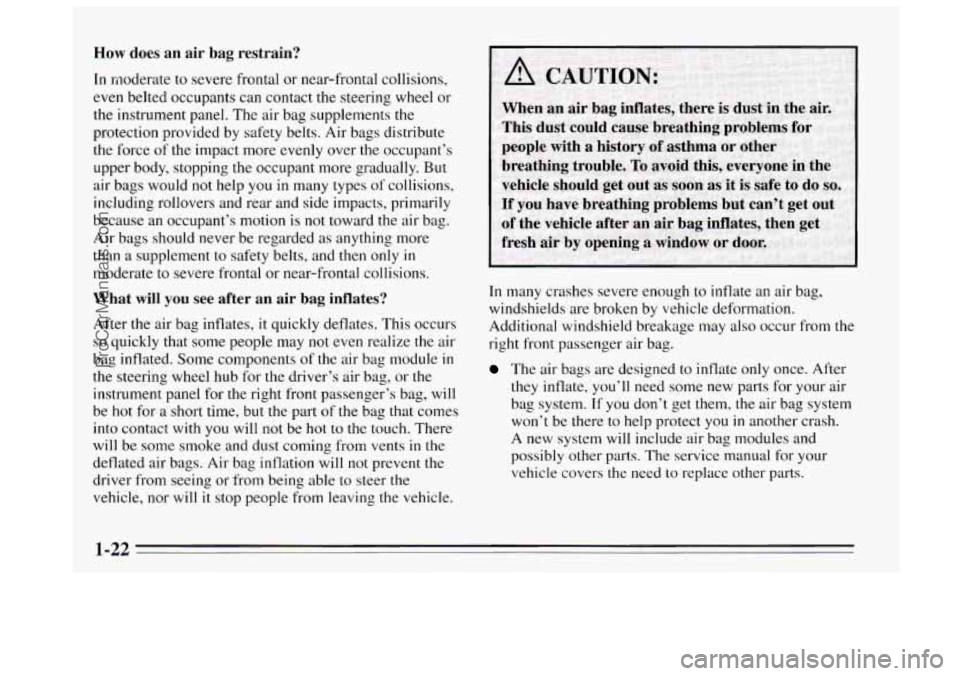
How does an air bag restrain?
In moderate to severe frontal or near-frontal collisions,
even belted occupants
can contact the steering wheel or
the instrument panel. The air bag supplements
the
protection provided by safety belts. Air bags distribute
the force of the impact more evenly over the occupant’s
upper body, stopping the occupant more gradually. But
air bags would not help you in many types of collisions,
including rollovers and rear and side impacts, primarily
because an occupant’s motion is not toward the air bag.
Air bags should never be regarded as anything more
than
a supplement to safety belts, and then only in
moderate to severe frontal or near-frontal collisions.
What will you see after an air bag inflates?
After the air bag inflates, it quickly deflates. This occurs
so quickly that some people may not even realize the air
bag inflated. Some components of the air bag module
in
the steering wheel hub for the driver’s air bag, or the
instrument panel for the right front passenger’s bag, will
be
hot for a short time, but the part of the bag that comes
into contact with you
will not be hot to the touch. There
will be some smoke and dust coming from vents
in the
deflated air bags. Air bag inflation will not prevent the
driver from seeing or from being able to steer the
vehicle, nor will
it stop people from leaving the vehicle. In
many crashes severe enough to inflate an air bag,
windshields are broken by vehicle deformation.
Additional windshield breakage may
also occur from the
right front passenger air bag.
The air bags are designed to inflate only once. After
they inflate,
you’ll need some new parts for your air
bag system.
If you don’t get them, the air bag system
won’t be there to help protect you
in another crash.
A
new system will include air bag modules and
possibly other parts. The service manual for your
vehicle covers the need to replace other parts.
1-22
-- -
ProCarManuals.com
Page 35 of 340
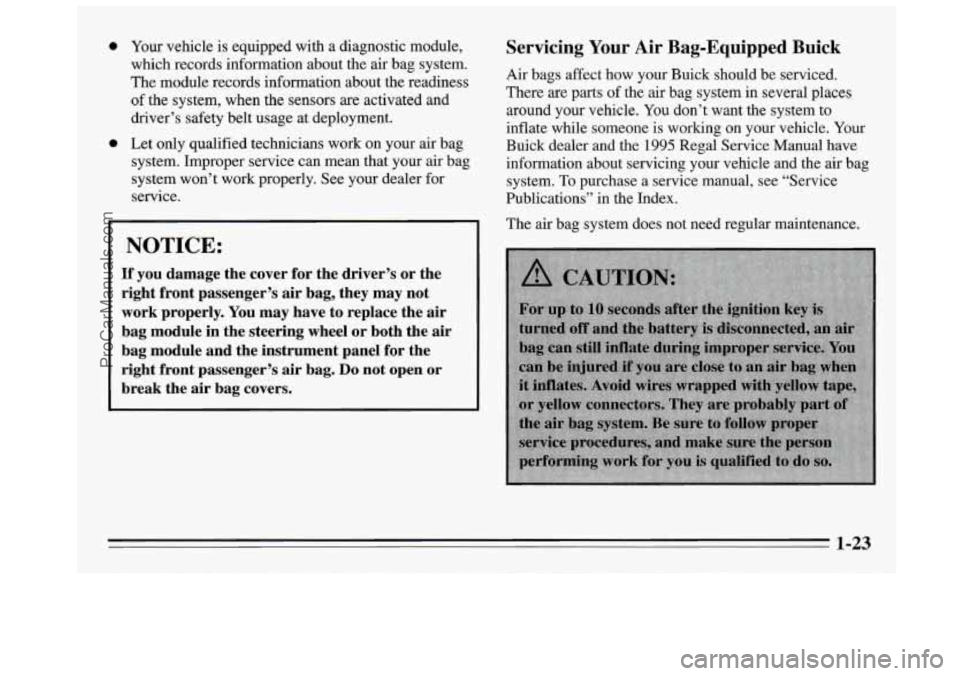
a
a
Your vehicle is equipped with a diagnostic module,
which records information about the air bag system.
The module records information about the readiness
of the system, when the sensors are activated and
driver’s safety belt usage at deployment.
Let only qualified technicians work on your
air bag
system. Improper service can mean that your air bag
system won’t work properly. See your dealer for
service.
I NOTICE:
If you damage the cover for the driver’s or the
right front passenger’s air bag, they may not
work properly.
You may have to replace the air
bag module in the steering wheel or both the air
bag module and the instrument panel for the
right front passenger’s air bag.
Do not open or
break the air bag covers.
Servicing Your Air Bag-Equipped Buick
Air bags affect how your Buick should be serviced.
There
are parts of the air bag system in several places
around your vehicle. You don’t want the system
to
inflate while someone is working on your vehicle. Your
Buick dealer and the 1995 Regal Service Manual have
information about servicing your vehicle and the air bag
system.
To purchase a service manual, see “Service
Publications” in the Index.
The air bag system does not need regular maintenance.
I I
1-23
ProCarManuals.com
Page 67 of 340
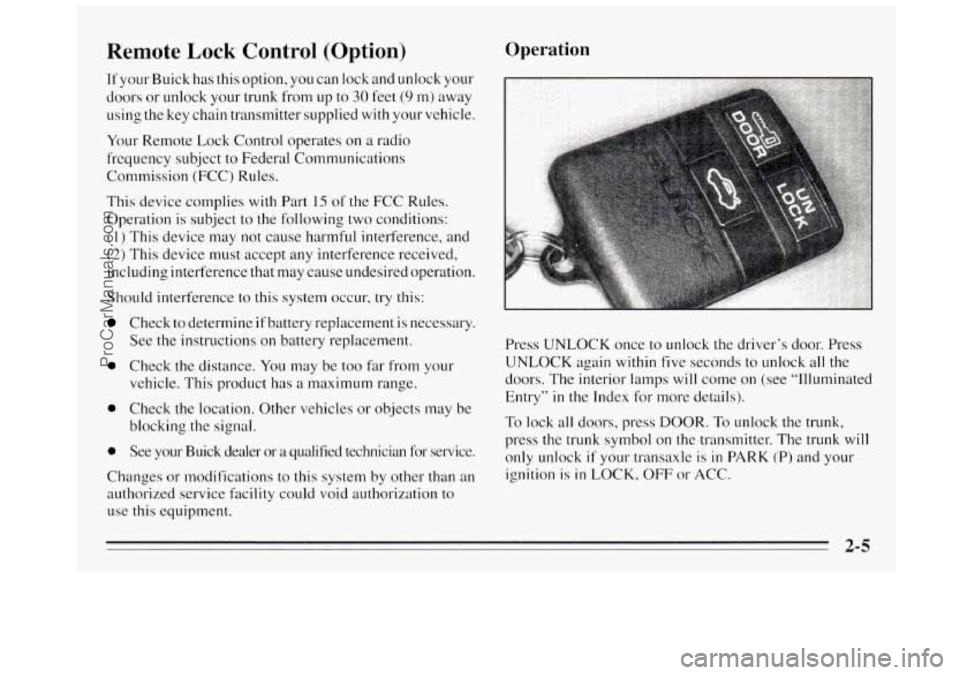
Remote Lock Control (Option)
If your Buick has this option, you can lock and unlock your
doors or unlock your trunk from
up to 30 feet (9 m) away
using the key chain transmitter supplied with your vehicle.
Your Remote Lock Control operates
on a radio
frequency subject to Federal Communications
Commission (FCC) Rules.
This device complies
with Part 15 of the FCC Rules.
Operation is subject
to the following two conditions:
(1 ) This device may not cause harmful interference, and
(2) This device must accept any interference received,
including interference that may cause undesired operation.
Should interference to this system occur,
try this:
Check to determine if battery replacement is necessary.
See the instructions on battery replacement.
0 Check the distance. You may be too far from your
vehicle. This product has a maximum range.
0 Check the location. Other vehicles or objects may be
blocking the signal.
0 See your Buick dealer or a qualified technician for service.
Changes
or modifications to this system by other than an
authorized service facility could void authorization to
use this equipment.
Operation
Press UNLOCK once to unlock the driver’s door. Press
UNLOCK again within five seconds to unlock all the
doors. The interior lamps
will come on (see “Illuminated
Entry”
in the Index for more details).
To lock all doors, press DOOR. To unlock the trunk,
press the trunk symbol on the transmitter. The
trunk will
only unlock if your transaxle is in PARK (P) and your
ignition is
in LOCK, OFF or ACC.
2-5
ProCarManuals.com
Page 71 of 340

PASS-Key@II
Your vehicle is equipped
with the PASS-Key%
(Personalized Automotive
Security System) theft
deterrent system.
PASS-Key% is a passive
theft deterrent system. This
means
you don’t have to do
anything different
to arm or
disarm the system.
It works when you insert or remove the key from
the
ignition. PASS-Key% uses a resistor pellet in the ignition
key that matches
a decoder in your vehicle.
When the PASS-Key% system senses that someone is
using the wrong key, it shuts down the vehicle’s starter and
fuel systems. For about three minutes, the starter won’t work and fuel won’t go to the engine. If someone tries to
start your vehicle again or uses another key during this
time, the vehicle will
not start. This discourages someone
from randomly trying different keys with different resistor
pellets in
an attempt to make a match.
The ignition key must be clean and dry before it’s
inserted in the ignition or the engine may not start. If the
engine does not
start and the SECURITY light is on, the
key may be dirty or wet. Turn the ignition off. Clean and dry the
key. Wait about three minutes and try
again. The security light may remain on during this
time. If the starter still won’t work, and the key appears
to be clean and dry, wait about three minutes and try
another ignition key. At this time, you may also want
to
check the fuse (see “Fuses and Circuit Breakers” in the
Index). If the starter won’t work with the other key, your
vehicle needs service. If your vehicle does start,
the first
ignition key may be faulty. See your Buick dealer or a
locksmith who can service
the PASS-Key@II.
If you accidentally use a key that has a damaged or
missing resistor pellet, the starter won’t work, and the
SECURITY light will flash. But
you don’t have to wait
three minutes before trying another ignition key.
See your Buick dealer or a locksmith who can service
the PASS-Key%
to have a new key made.
If you’re ever driving and the SECURITY light comes
on, you will be able to restart your engine if you turn it
off. Your PASS-Key% system, however, is not
working properly and must be serviced by
your Buick
dealer. Your vehicle is not protected by the
PASS-Key@II system.
If you lose or damage a PASS-Key% ignition
key,
see your Buick dealer or a locksmith who can service
PASS-Key@II
to have a new key made.
2-9
ProCarManuals.com
Page 73 of 340
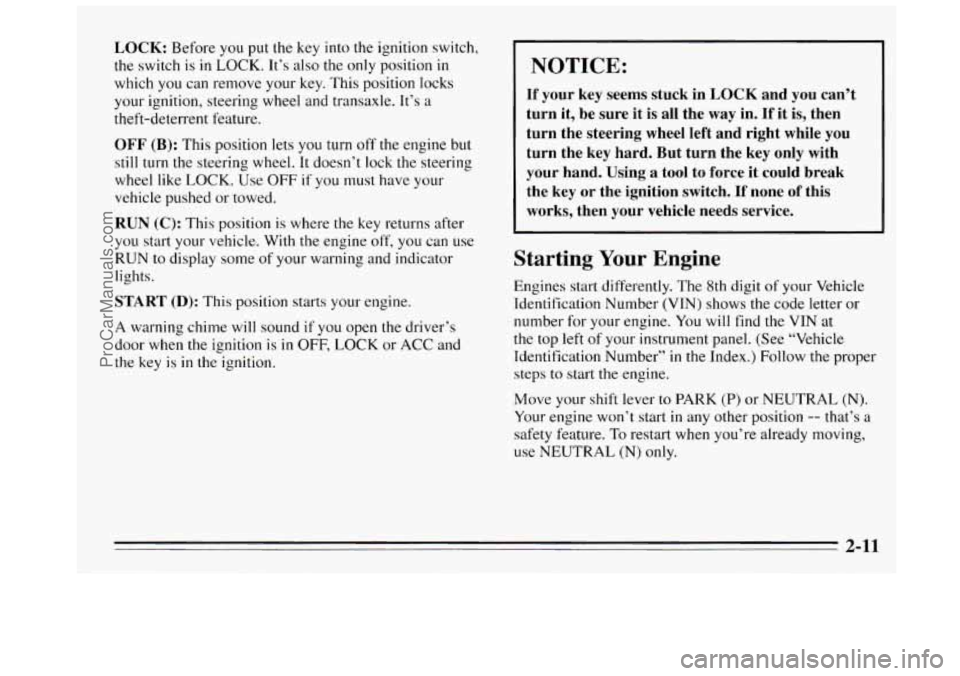
LOCK: Before you put the key into the ignition switch,
the switch is in
LOCK. It’s also the only position in
which you can remove your key. This position locks
your ignition, steering wheel and transaxle. It’s a
theft-deterrent feature.
OFF (B): This position lets you turn off the engine but
still turn the steering wheel. It doesn’t lock the steering
wheel
like LOCK. Use OFF if you must have your
vehicle pushed or towed.
RUN (C): This position is where the key returns after
you start your vehicle. With the engine off,
you can use
RUN to display some
of your warning and indicator
lights.
START (D): This position starts your engine.
A warning chime will sound if you open the driver’s
door when
the ignition is in OFF, LOCK or ACC and
the key is
in the ignition.
NOTICE:
If your key seems stuck in LOCK and you can’t
turn it, be sure it is all the
way in. If it is, then
turn the steering wheel left and right while you
turn the key hard. But turn the key only with
your hand. Using a tool to force it could break
the key or the ignition switch. If none of this
works, then your vehicle needs service.
Starting Your Engine
Engines start differently. The 8th digit of your Vehicle
Identification Number (VIN) shows the code letter
or
number for your engine. You will find the VIN at
the top
left of your instrument panel. (See “Vehicle
Identification Number” in
the Index.) Follow the proper
steps to start
the engine.
Move your shift lever
to PARK (P) or NEUTRAL (N).
Your engine won’t start
in any other position -- that’s a
safety feature. To restart when you’re already moving,
use NEUTRAL
(N) only.
2-11
ProCarManuals.com